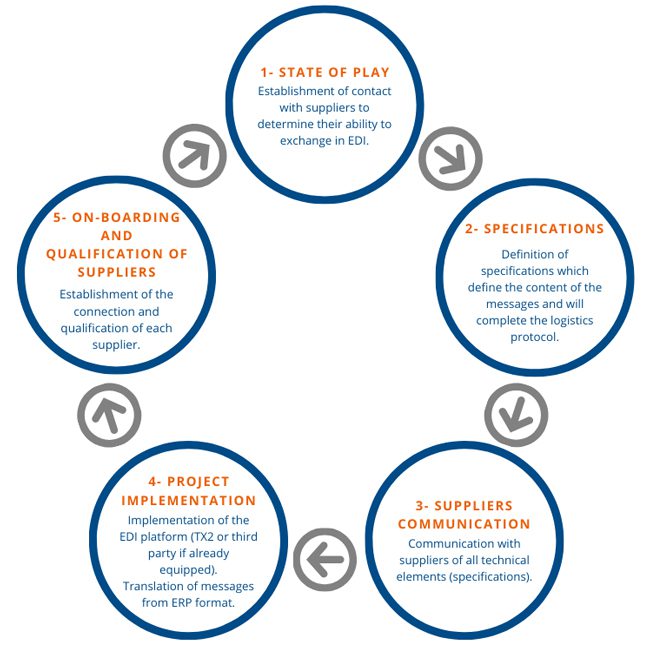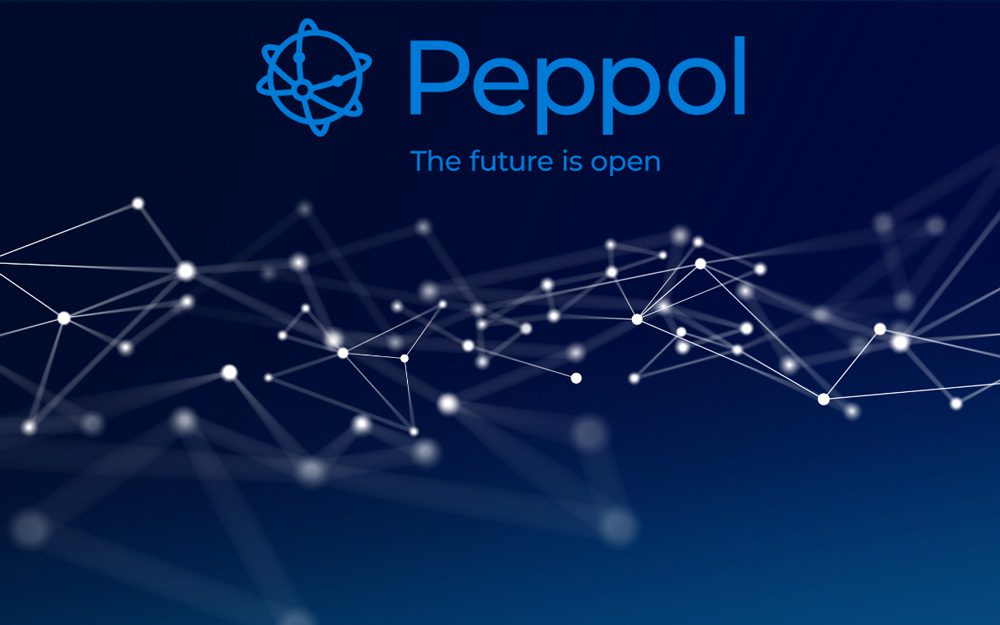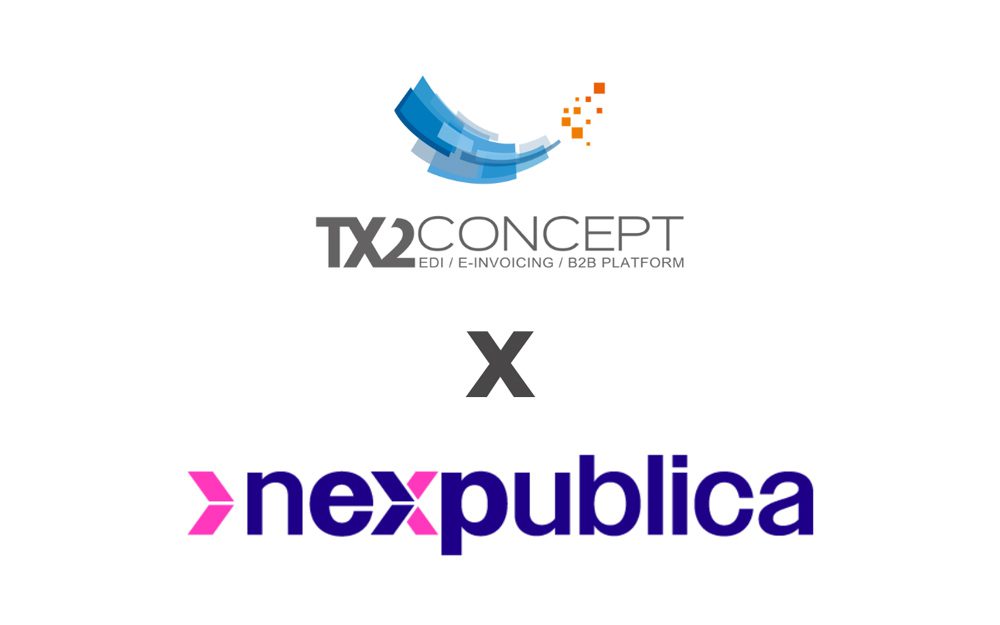You want to automate information exchange with all of your suppliers using Electronic Data Interchange (EDI)? Opt for the implementation of a supplier EDI.
This solution allows you to automate exchanges with your suppliers. You can, for example, automate the management process from sending the order to receiving the invoice, including receiving the shipping notice. It is possible to implement such a solution with all your suppliers, regardless of their size.
Reminder on Electronic Data Interchange
Electronic Data Interchange replaces paper documents exchanged between companies. With an EDI solution, a company exchanges its commercial documents with its partners automatically via standardized messages.
Orders, shipping notices or invoices, for example, are exchanged directly through a computer-to-computer connection and can be automatically integrated into the management system, such as an ERP, or the partners’ accounting software.
To learn more about how EDI works, do not hesitate to consult our article What is EDI? Simple and clear explanations.
Who are the players in a supplier EDI project?
In general, in an EDI project, we find the Major Contractor on one side and his suppliers on the other. To be as clear as possible and to make sure that we speak the same language, let’s do a little reminder.
The company that orders goods and/or services from a supplier is called Major Contractor. A Major Contractor is therefore a buyer, or generally a client. As part of a supplier EDI implementation, it is the client who initiates this implementation. He’s the one who wishes to generalize EDI with all of his suppliers. It is therefore the one who will be able to impose its messages, its standards, its calendar, etc.
The 5 steps of a supplier EDI implementation
Here are the 5 main steps to follow for a successful Supplier EDI implementation:
1. Supplier onboarding phase: Supplier state of play
This first step consists in contacting all the suppliers that you wish to integrate into this project. You must therefore make a state of play to determine:
- Which suppliers to onboard
- Which suppliers are able to exchange flows using EDI, whether they already have an EDI solution or not.
It is quite possible to implement EDI in “wave”. In this case, you can group your suppliers according to different criteria, such as turnover, the most strategic partners or even according to the volume of documents exchanged.
On the side of your suppliers, different situations are possible:
- Your supplier has an integrated EDI solution: He must develop and adapt his system in order to implement the new flows. For our part, we take care of qualifying the supplier via an approval portal and planning the production launch.
- He does not have an EDI solution but he’s able to implement one in integration with his ERP: We offer him an EDI solution in SaaS mode or in license.
- He does not wish or is not able to install an EDI solution in integration with his ERP: We offer him a Web EDI solution. We will see this in more detail below.
It is preferable that this step be carried out internally, given the existing client-supplier relationship. However, if you wish, this step can also be carried out by your EDI service provider.
2. Definition of the specifications
With the objective of avoiding the multiplication of specific management rules on the client side, it’s essential to define EDI specifications that will be imposed on suppliers. This defines in particular the messages to be exchanged, the norms or standards used, the possible communication protocols and the data necessary for your management system. It will be distributed to your partners upstream and will simplify the next stages of the project.
On our side, TX2 CONCEPT has a technical advisory role during this stage. It is your ERP that will be able to tell us what data can be integrated into the exchange files.
3. Communication with suppliers
Now that you have identified the suppliers and defined the specifications, the next step is to communicate the technical elements to your suppliers.
You then have two options: take charge of this communication internally or delegate this task to your service provider.
The objective here is to send suppliers an onboarding letter as well as a user guide for the qualification portal (see step 5). Depending on the feedback received, it will be necessary to contact the suppliers and confirm their integration into the project.
In this communication, we advise you to explain to your partners the benefits they can withdraw from this transition to EDI. They will then be more inclined to follow you in this project.
4. Implementation of the EDI solution
This step differs depending on your current situation:
- You have our Client EDI SaaS solution? Our TX2 Business Linked® platform remains unchanged. New flows will pass through it.
- You have a Client EDI SaaS solution from a third-party EDI provider? You have two options: either you choose to switch to TX2 CONCEPT for the entire Supplier EDI part, or you use your current platform. In this case, your service provider will have to set up the EDI flows that we will have defined together beforehand. We will simply take care of the supplier onboarding part.
- You don’t have an EDI solution? You will have to opt for an EDI solution offered by TX2 CONCEPT or another service provider.
This step also relies on the collaboration between your EDI service provider and your ERP editor in order to define a file structure. Indeed, the flows will have to be translated between the standardized file defined in the specifications and the file provided by your ERP.
5. Supplier qualification and approval portal
Now is the time to onboard your suppliers by possibly allowing them to qualify through an approval portal.
This step allows you to create connections between you and your suppliers. It is the establishment of the mode of communication. It is also about testing supplier flows. We thus check the conformity of the EDI messages and documents exchanged.
Once the quality of the messages has been tested, the transition to production can begin. You can start sending your documents in EDI format to your suppliers.

Extension of EDI with your suppliers: What advantages to expect?
Generalizing dematerialized exchanges with your partners increases the advantages provided by EDI. The more the number of partners and messages increases, the more you maximize these benefits.
Thanks to electronic data interchange, your administrative, purchasing and sales teams gain in productivity and performance. The reduction in response times for your partners and the automation allowed by the automatic integration of all your flows bring them speed and efficiency.
You reduce your processing costs and improve the traceability of your exchanges. This is made possible because EDI limits the number of intermediaries and allows you to access the complete history of your flows.
These advantages actually improve the quality of your commercial relations thanks to a reduction in the risk of disputes.
The implementation of EDI on the supplier side
Now let’s see how the implementation of supplier EDI works on the supplier side.
EDI implementation
As we said above, if your suppliers do not have an EDI solution, we offer them different solutions adapted to their needs.
They can opt for an EDI offer in SaaS or in license, integrated into their ERP.
They can also opt for a lighter solution called Web EDI. This adapts to all suppliers who do not have the capacity to set up an EDI integrated into an ERP. The supplier then has an online platform that allows him to receive his orders and manually send his shipping notices and invoices.
For the client, this choice is completely transparent. The flows are exchanged in the same way.
Mistakes to avoid on the supplier side
- See the transition to EDI as a constraint imposed by your client
In order to maintain good commercial relations with your client, you respond favourably to his request but this seems to you to be a major constraint? First of all, be aware that in the context of a supplier EDI implementation, most of the costs can be borne by your client. This allows you to enjoy the benefits of EDI without bearing all of the associated costs. EDI can greatly simplify your internal processes and increase your productivity.
- Not taking into account the fact that several Major Contractors may wish to switch to EDI
For efficiency, it is important to consider the fact that many of your clients may use EDI. It may be relevant to generalize EDI to all your clients.
Each of them can request its own EDI format and use different EDI standards. By asking your partners beforehand about their willingness to use EDI and the standards they use, you avoid the multiplication of translation mappings.
Indeed, let’s say that one of your Major Contractors makes you choose between two different standards: D93a and D96a. If you haven’t checked with your other clients, you might be tempted to choose the D93a standard when the majority of your other clients use the D96a. You will therefore have 2 translations to manage instead of just one. By making a state of play of your clients, you could reduce your implementation costs.
- Not prioritizing the messages to implement
But what message to start with? See internally what are the gains brought by each type of message and you will know where to start. Be careful, however, because your Clients will want the messages for which they have the most significant gains. Try to find the right balance between your needs and theirs. TX2 can support and advise you during this step.
- Forgetting that you are also the client of various suppliers
You are switching to EDI with some or all of your clients, so why not generalize it with your suppliers as well? This allows you to maximize the benefits of your new EDI system.
In this case, you can launch your own Supplier EDI implementation yourself! The steps seen previously then apply to this new project.
If you have any questions or would like to know more about our Supplier EDI offer, don’t hesitate to contact us.
Schedule a call
